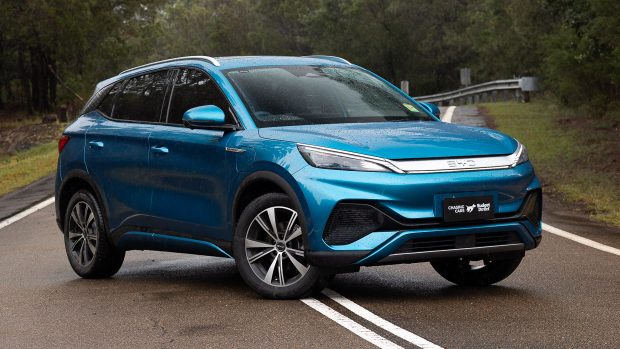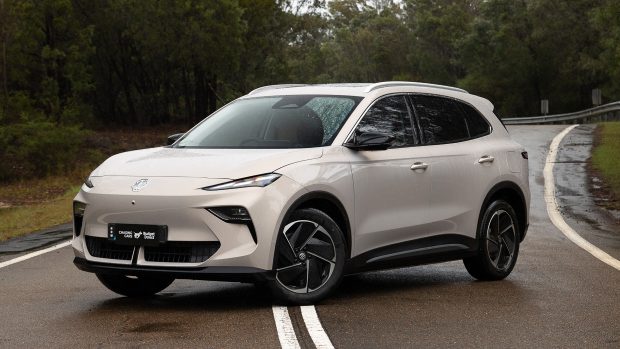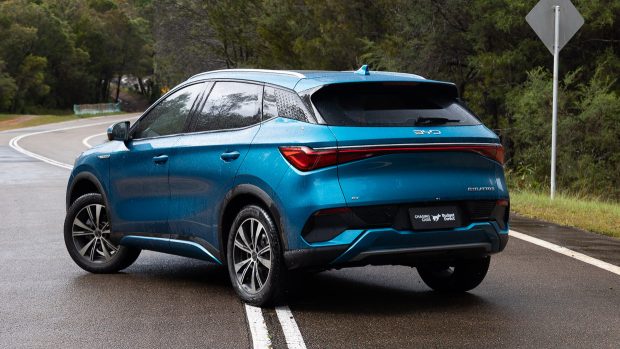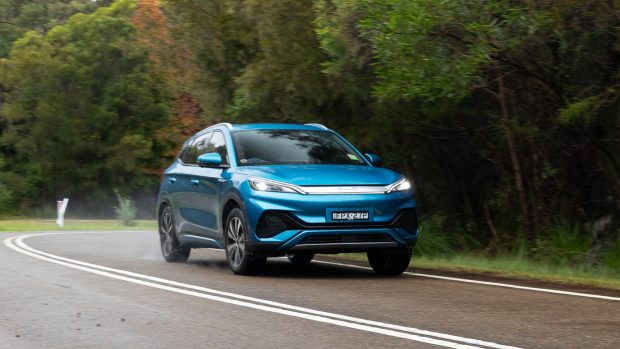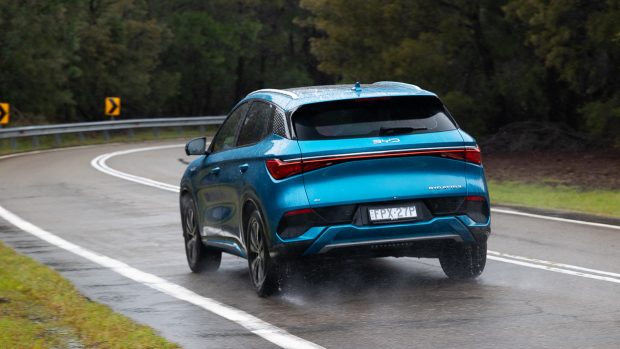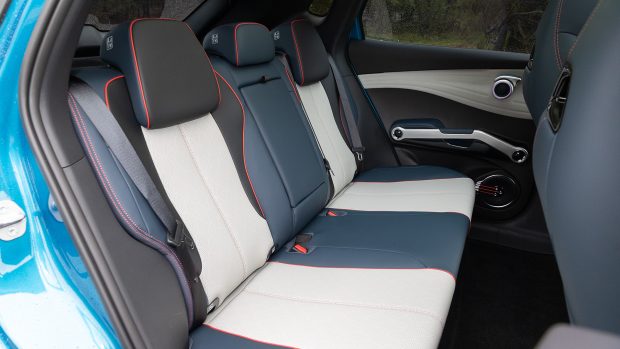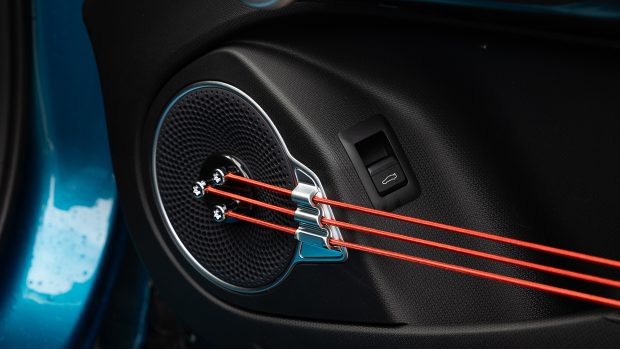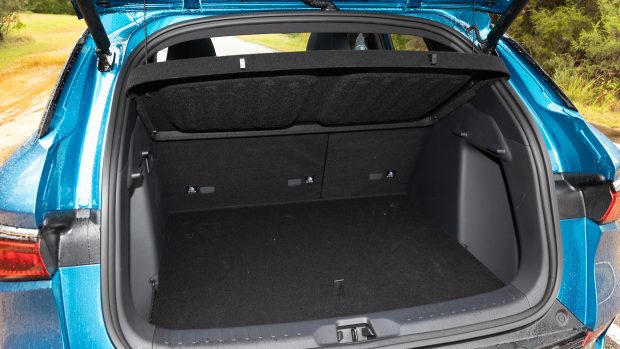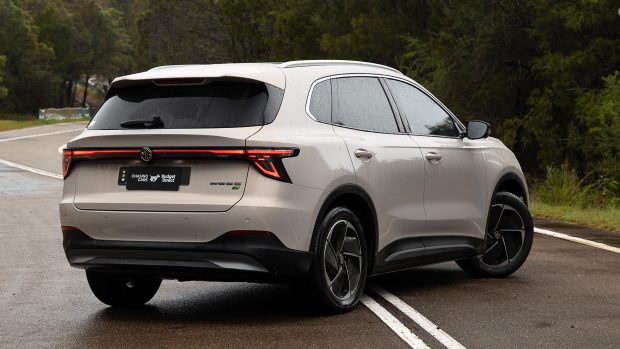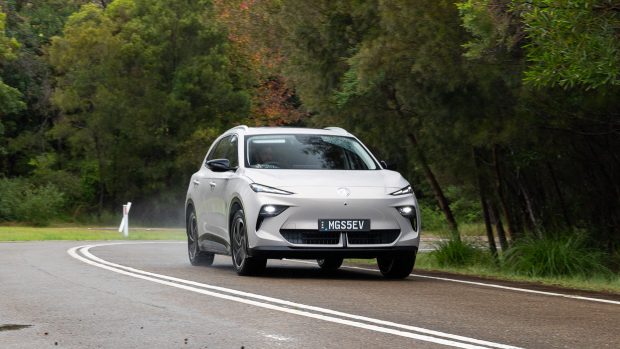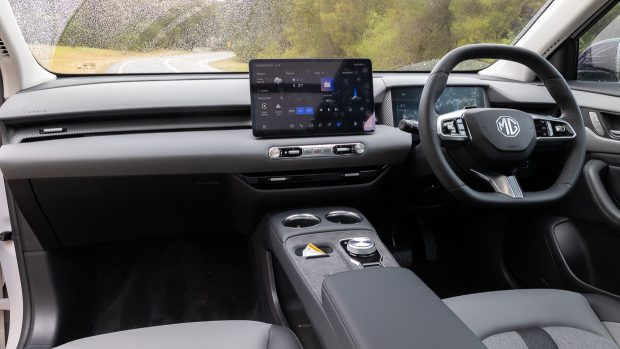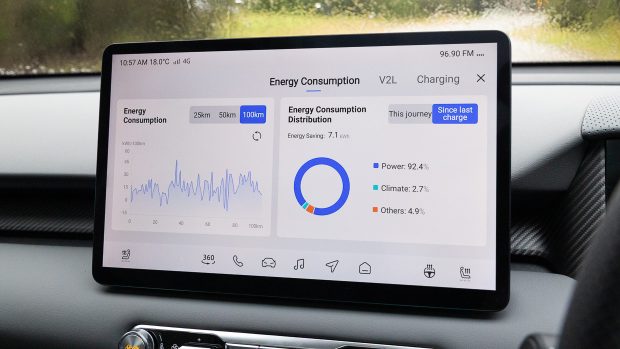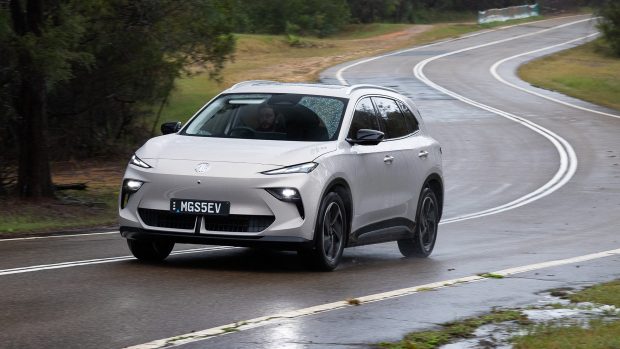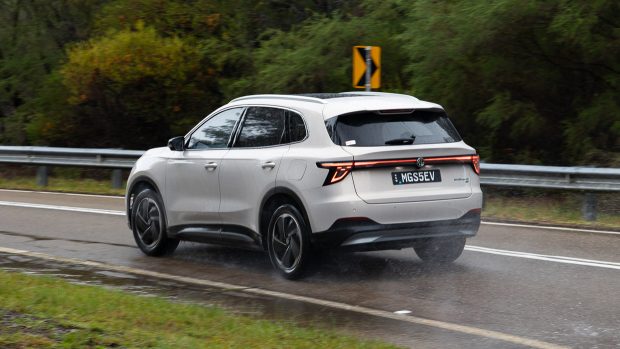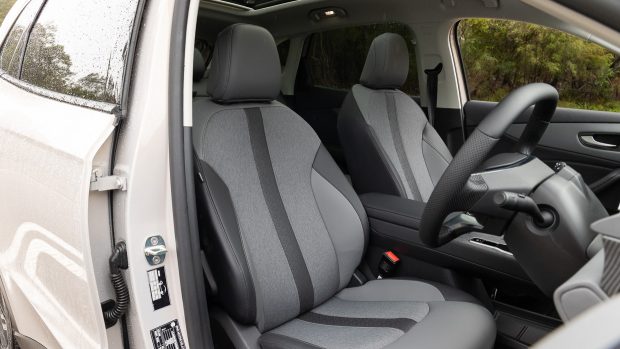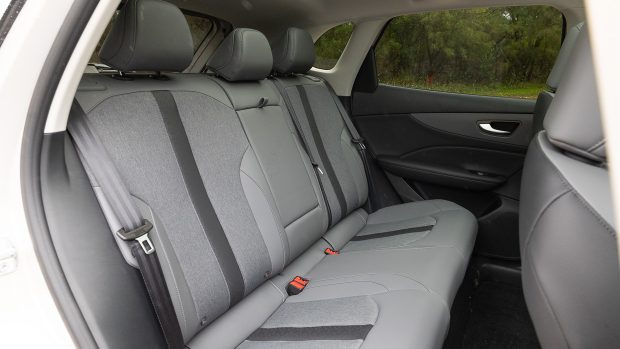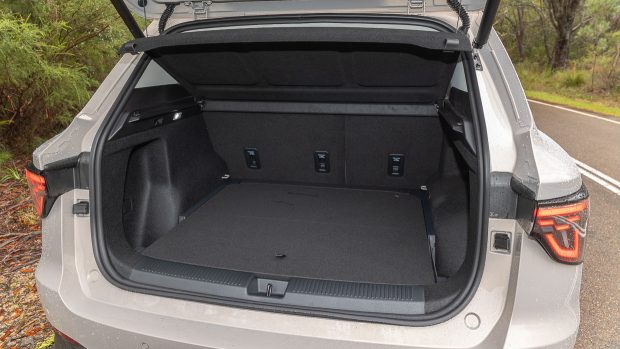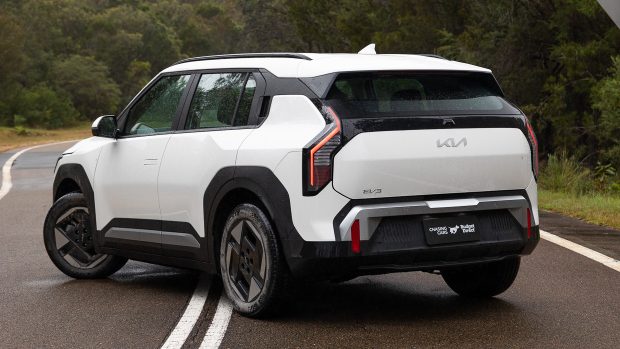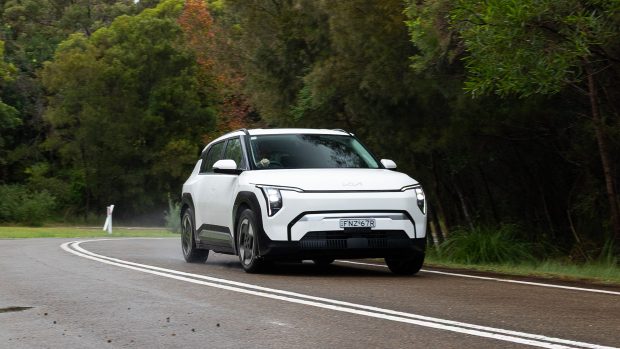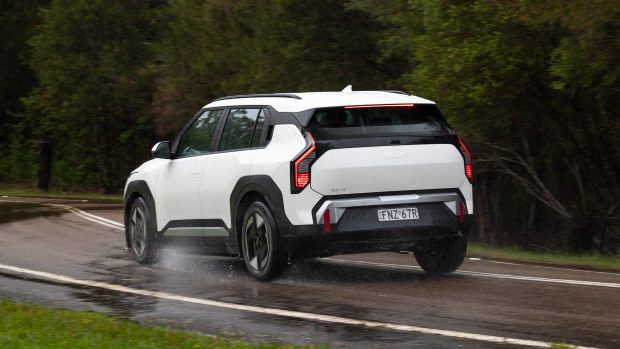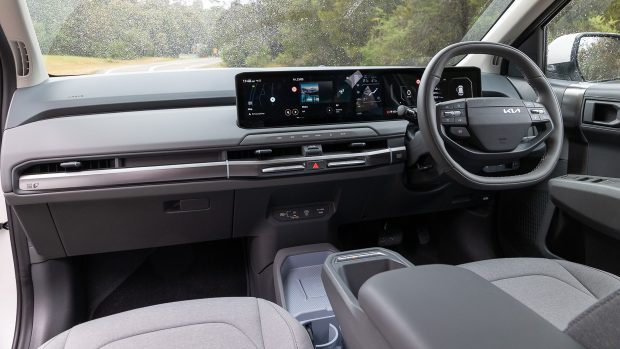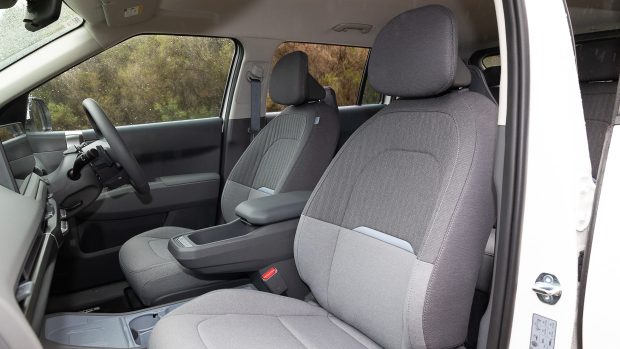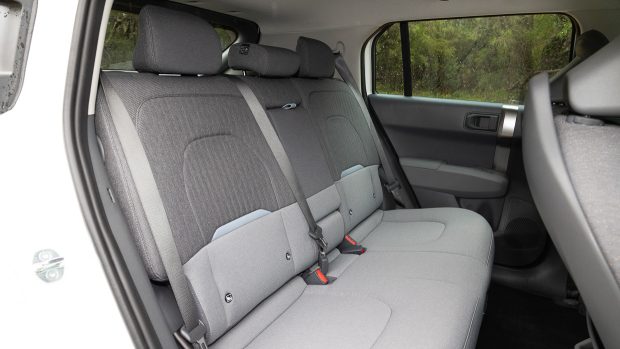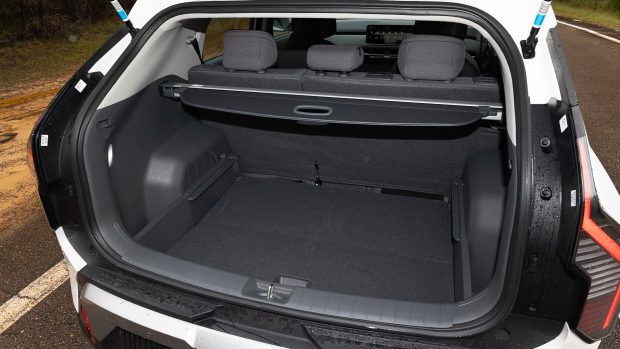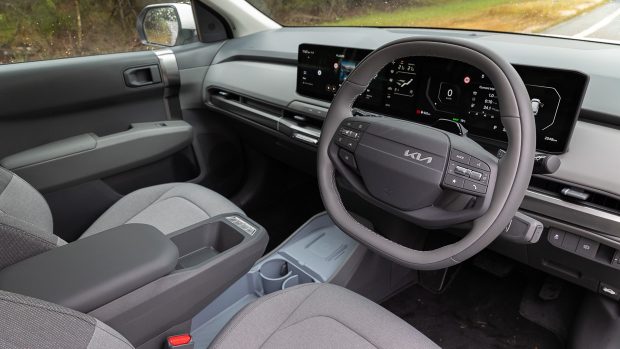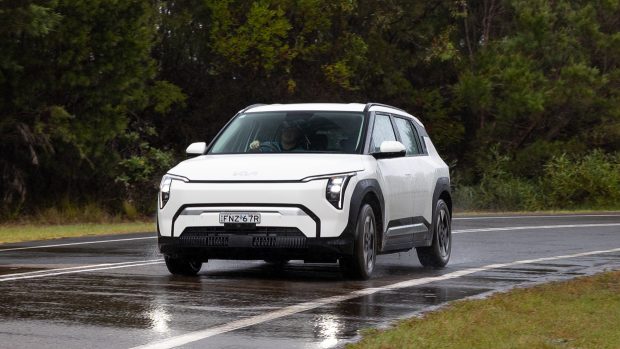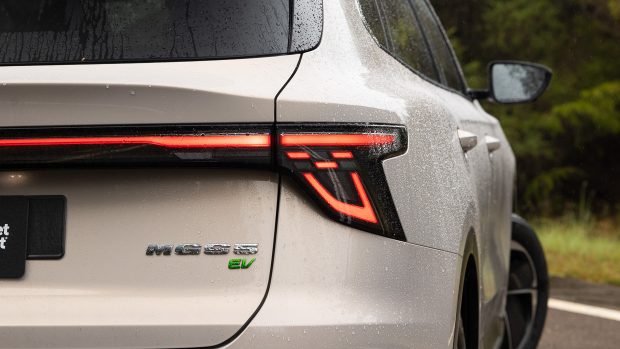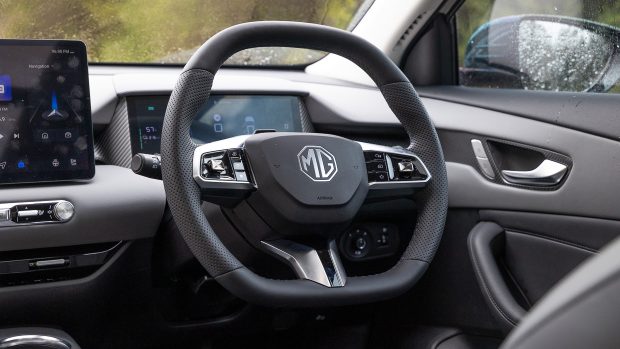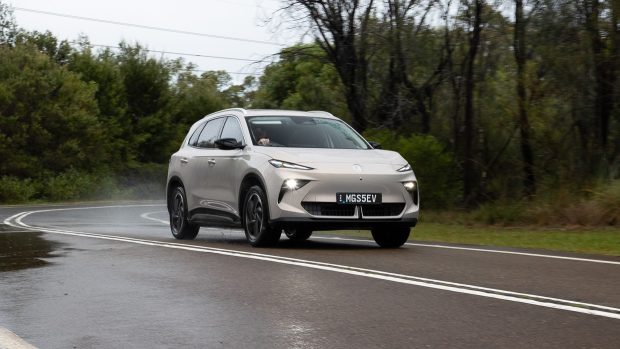-
Car Reviews
- All reviews
- Midsize SUVs
- Small cars
- Utes
- Small SUVs
- Large SUVs
- Large cars
- Sports SUVs
- Sports cars
- Vans
Latest reviews
- Car News
-
Car Comparisons
Latest comparisons
- Chasing Deals
If ‘under $50K’ and ‘shorter than 4.5 metres’ are crucial data in your search for a electric SUV, then this charming trio should be top of your list
As the dividing line between size classes and vehicle types continues to blur – and the price differential between fully-electric and petrol propulsion is dramatically reduced – the choice among small-to-medium electric SUVs has never been more persuasive.
Yet we’re only presenting you with three options in this comparison test – the debut model for BYD in Australia (the now three-year-old Atto 3) lined up against two brand spanking new EV rivals, all priced within $1000 of each other once you drive away from the dealership.
The freshest meat is the MG S5 EV – a direct replacement for the ageing (and awful) ZS EV. Based on the same rear-wheel-drive modular platform as the impressive MG 4, the new MG S5 features identical battery sizes, similar range, and a similarly handling-focused driving experience to its small hatch sibling.
But has this ‘all-new’ MG moved the game on enough inside to make a much-needed quality impression?
The other newcomer is Kia’s undoubtedly small electric SUV – the EV3. Sharing the same underpinnings as the Hyundai Kona EV but improved enough to make it feel like a premium-brand alternative, the EV3 feels like a cut-price EV9 in the way it looks and drives.
But does the smaller Kia have the passenger space to rival the BYD and MG? And is our base-model EV3 Air test car well-equipped enough to challenge its top-spec Chinese competitors?
| Good points (limit to 5-6 words) | Needs work (limit to 5-6 words) |
| Ample passenger space | Flawed cabin storage |
| Fluent and poised handling | Considerable road noise |
| Gutsy eight-speaker stereo | Bland exterior design |
| High-quality tyres | Long-ish charging time |
| Strong performance | Below-average warranty coverage |
In the three years that the Atto 3 has been on sale in Australia, BYD has subtly finessed this smallish medium electric SUV into becoming a surprisingly good thing.
Step one was removing the cringeworthy ‘Build Your Dreams’ badging from its tailgate, which took longer than it should have.
And this latest MY25 iteration introduces new alloy-wheel designs fitted with good-quality 235/50R18 Continental tyres, as well as what feels like some under-the-skin refinements to make the 2025 BYD Atto 3 noticeably better to drive than its predecessors.
Ditching the previous (dreadful) Chinese-made Batman tyres for some proper footwear has introduced a satisfying fluency to the Atto 3’s dynamics. It feels poised in corners, grips the road well, and its steering is consistently weighted, progressive and nicely responsive, even in breezy Comfort mode.
The BYD rides well, too, with surprising suspension absorbency and robustness on challenging surfaces, though it does rock around a bit over lumps. Our only real criticism is the amount of road noise it transmits – on all surfaces, even in the rain. It’s the one area where the Atto 3 feels considerably older than its MG and Kia rivals.
The BYD’s regenerative braking function is also less than ideal. While smoothly progressive, combined with quite natural brake-pedal feel, its regen’ braking is simply too ineffectual, even when set to its most extreme level.
This might seem like a smart way to ease non-EV drivers into the quirks of electric motoring, but it doesn’t really blend with (or enhance) the BYD’s dynamics and it just isn’t assertive enough.
Few will complain about the BYD’s acceleration, however, as it smoothly and progressively transmits 150kW/310Nm to the front wheels, thrusting itself to 100km/h in a claimed 7.3sec.
It does a better job of gradually unleashing grunt than the Kia, resulting in less wheelspin but also less of a performance sensation – meaning this is one Chinese EV that knows how to round off sharp edges. Yet if you want more shove off the line, there’s always Sport mode.
The main area where the Atto 3 divides opinion is in its overall design – both outside and inside.
The Atto 3’s exterior is, for the most part, blandly inoffensive with a relatively neat shape and pleasing details. Full-width light bands, front and rear, give it some razzle-dazzle at night but in 2025, it’s an ageing design compounded by a depressingly slim choice of hues (four in total).
Even the Premium-spec-only Surf Blue looks like a hero colour from 15 years ago.
In contrast, the Atto 3’s overdesigned interior looks like it belongs to another car – or at least another BYD – though details such as its Art Deco-esque air vents are really quite cool.
The dashboard’s ‘organic’ shapes and various strakes are mitigated in the black interior option (with mid-grey highlights and lime green seat piping), whereas the ‘blue and grey’ alternative brings light grey centre inserts with blue bolsters, red piping highlights and quirky red ‘guitar string’ door pocket holders, which can strum a basic tune!
The upholstery is all vinyl (though perforated in the cushion and backrest centres), which is fine in winter but a little clammy in summer, seeing there’s no cooling ventilation, only front-seat heating.
The driver is also the only front occupant to get electric seat and height adjustment, though it’s a basic six-way set-up lacking under-thigh tilt or lumbar tweaking. Thankfully, they’re nicely shaped with great lateral support for a decent driving position.
The rear seat isn’t quite as supportive but it’s more than acceptable, with a fully flat floor, plenty of room (apart from perhaps headroom) and a vast glass roof with full-length electric blind and opening sunroof to lighten the atmosphere and expand the already-excellent vision.
Pity the BYD’s storage is so pathetic – tiny door bins with space for very small, oddly angled plastic bottles in the front and maybe a handful of Minties in the rear. The front cupholders are also flawed – maxxed out with a large coffee and a small can of Red Bull. Oh, there’s two of you with take-away coffees? Then tough bikkies.
Its boot isn’t huge either – 440 litres below the luggage cover, though that’s entirely workable – but what is undoubtedly massive is BYD’s signature 15.6-inch touchscreen on this Premium variant.
Famed (or infamous) for rotating between portrait and landscape orientation (though it’s landscape only for wireless Apple CarPlay), its ease of operation is better than most Chinese systems, and the sound quality from its eight-speaker Dirac HD stereo is the best of this bunch.
The likeable BYD Atto 3 Premium ultimately does few things better than its newer rivals – including charging times (see Energy Efficiency, Range and Cost of Ownership) – for virtually the same money.
But if you can handle its avant-garde interior design, it’s a surprisingly painless car to live with – electronic safety systems included. And that’s a big statement.
| Good points | Needs work |
| Handsome appearance | Firm ride around town |
| Crisp, keen steering response | Acceleration could be stronger |
| Well-balanced handling | No height-adjustable front passenger seat |
| Surprising interior warmth and class | Luggage space lacks Kia’s flexibility |
| Programmable safety aids | Could easily pull off a proper luxury spec |
| Impressive one-pedal braking mode | Big-battery range same as small-battery Kia |
An automotive award for ‘Most Improved Car’ still wouldn’t adequately convey just how dramatically transformed the new MG S5 EV is compared to the ZS EV it replaces. As far as polar opposites go, these small electric SUVs are night and day. Or, more accurately, good and evil.
It was smart engineering by MG to reject an electric development of the combustion-engined, new-generation ZS small SUV and instead start with a bespoke EV platform – that being the highly praised rear-drive underpinnings of the MG 4 small hatch.
And then select a new name – ditching the icky-tasting residue of ‘ZS EV’ and instead opting for S5 EV. Officially, it’s called MGS5 EV (all jammed together) – to somehow avoid the wrath of Audi and its two-decade association with the ‘S5’ nameplate.
Yet mark our words, this is easily the best car that Chinese-owned MG has delivered so far, eclipsing its MG 4 cousin for all-round ability while putting the deeply mediocre, depressingly superficial new MG HS into perspective.
What all that essentially means is this small-to-mid-sized electric SUV offers a more consistent all-round driving experience than an MG 4, with far superior interior quality and powertrain response to an HS, for vaguely similar money.
The list price on this top-spec, big-battery S5 Essence is $47,990 driveaway, which is $5K less than what MG is currently charging for the forthcoming base HS Hybrid Excite, and $7K more than a petrol HS Essence. But, more importantly, it’s within a grand of what its rivals cost in this comparison test, with the MG marginally the most affordable.
Aside from the fact that it’s quite handsome to look at, what you immediately notice about the MG S5 on first acquaintance is its interior.
Cohesively designed and consistently built, it has a uniformity to the materials used that conveys a care-factor beyond mere cost consciousness. Sure, it’s no luxury car, but at the same time, it could carry off some fancy special-edition luxury trimmings without looking like lipstick on a pig.
Multi-tone colouring, a faux carbonfibre dashboard inlay, a suede-like surface for the wireless phone charging platform and actual cloth seat inserts (finally!) on an up-spec variant give the S5 Essence a textural warmth like no MG SUV before it.
Plus there’s some intelligent, nicely designed physical switchgear and an all-new 12.8-inch multimedia touchscreen that decimates the previous MG system for processing speed, overall clarity and ease of use.
It also gains wireless Apple CarPlay and Android Auto, which is effortlessly simple to connect, and there’s even an ‘MG Pilot Custom’ button that you can program all of your chosen active-safety settings into, meaning irritation-free motoring is just one simple icon-press away.
In that one area alone, the S5 EV is a genuine game-changer.
That said, this MG’s electronic safety systems are much more finessed than before, and apart from the somewhat-insistent three-beep overspeed warning, there’s now much less need to nullify their operation.
About the only area where the S5 could probably benefit from more attention is by offering an ESC Sport mode, because its chassis is keen enough, and capable enough, to be given an opportunity to breathe.
As it stands, even when you switch the stability-control off, it turns itself back on the moment it senses any movement from the MG’s rear end.
Yet that isn’t enough to quell the dynamic enthusiasm of this electric MG. Here is a small rear-drive wagon that has a genuine affinity for Australian roads – a vehicle type so rare in modern times that its closest forebears in terms of sizing and handling are the long-dead E46 BMW 3 Series Touring and W204 Mercedes C-Class Estate.
The tightly monitored MG S5 doesn’t offer the rear-drive handling adjustability of those German wagons but its uncorrupted steering is so crisp and keen, delivering instant directional response combined with the tactility of MG’s superb three-spoke steering wheel.
Close your eyes (!) and you could easily be piloting a rear-drive MG 4 … except the S5 has refined its ride quality to mitigate any vertical motion, while remaining tautly firm around town.
On challenging Australian country roads, the MG S5 handles lumps and bumps exceedingly well, with better refinement than the BYD and far-superior regenerative braking performance (with a proper one-pedal mode).
But with only 125kW/250Nm in its powertrain, the MG S5 is a little lacking in outright grunt (0-100km/h in a claimed 8.6sec), even though around-town driveability is generally excellent.
As for the rest of the package, it’s unexpectedly difficult to fault. There’s no height adjustment for the all-manual front passenger seat and the MG’s six-speaker stereo sounds a bit artificially digital compared to the BYD’s, but the rest of the interior is terrific.
That includes a comfortably well-shaped rear seat, plenty of space, ample door storage (as well as proper hand grips in the front) and a usefully flexible 453-litre boot.
Even the MG’s range and charging are quite competitive (see Energy Efficiency, Range and Cost of Ownership), yet all that stuff should be relatively easy to achieve in 2025.
What is far from a given is producing a car that’s genuinely pleasant to ride in and enjoyable to drive, for a relatively affordable price. With the disappointing HS medium SUV, MG has shown that those qualities remain elusive in some of its new models.
But the S5 EV is by far the most convincing MG yet – a genuinely impressive achievement that towers over much of the mind-numbing dross being exported from China for similar money.
But not the Kia EV3.
| Good points | Needs work |
| Brilliant packaging | Electric range merely acceptable |
| Excellent urban ride and refinement | Thick-set steering wheel spokes |
| Well-rounded dynamics | Average audio quality |
| Terrific front and rear boot space | No heated seats or electric tailgate |
| Awesome interior for a ‘base’ model | Steering weighting a touch heavy |
After the own-goal that seemed to be last year’s rather two-dimensional EV5 medium SUV, we weren’t quite sure what to expect from Kia’s smaller EV3.
Would it succeed in bottling all the goodness of the large EV9 electric SUV into a sweetly concentrated package? Or would it fall into the EV5’s trap – delivering space and seat comfort, but not driving enjoyment or refined sophistication?
Thankfully, it’s the former. The Kia EV3 very much feels like a distilled EV9 … if it were only 4.3m long, front-wheel drive and just $48,990 driveaway for the entry-level Air Standard Range variant.
Crazy as it sounds, it’s the elements of the EV9’s majestic road manners, futuristic shape and grand interior design that continue to shine through in the EV3.
Thanks to its bombproof perception and excellent refinement, the EV3 feels like a proper premium product, even though it’s essentially just a development of Hyundai’s Kona EV.
And while that might all seem a little far-fetched, it takes only a few minutes driving behind the EV3’s needlessly thick-set steering wheel to sense it. And that’s why this base, small-battery EV3 Air edges out the top-spec, big-battery MG S5 in overall standing.
Straight off the bat, the Kia doesn’t have the MG’s steering crispness and immediacy. It’s a front-wheel-drive EV transferring quite a bit more grunt to its narrower 215/60R17 Kumho front treads, combined with relatively meaty steering weighting, plus that aforementioned chubbed-up wheel shape.
Yet there’s an impregnability about the way the EV3 Air drives, and a deliciously quiet suppleness to the way it rides around town that elevates it to a higher level.
It has a calmness and a serenity to it … providing the driver has a degree of subtlety with their right foot because, despite its smooth demeanour, the Kia will happily scrabble its front tyres and tug a little from side to side when attempting to replicate its 7.5sec 0-100km/h claim with all 150kW and 283Nm on offer.
That said, find a twisty, bumpy, challenging Aussie country road and the EV3 Air will devour it with aplomb. It doesn’t feel as light on its feet as the rear-drive MG, but it turns in well, is sweetly balanced and remains resolutely planted in all conditions, with the on-its-game ESC mopping up the edges if the Kia’s tail begins to step out.
The EV3 also debuts Hyundai-Kia’s i-Pedal 3.0 regenerative braking system – now with several degrees of full one-pedal operation, adjustable via steering-wheel paddles – and it remains a benchmark in EV motoring, blending seamlessly with the EV3’s dynamics to solidify its EV character and capability. It also remembers your preference when you switch off.
Then there’s its cabin. This is a base-model Air, yet you’d never know it at first glance. The all-cloth seat facings feature classy textures and patterns, as well as height adjustment for both front passengers (unlike the BYD and MG).
They’re the most comfortable buckets here, even though they don’t offer heating (the mid-spec EV3 Earth gets heating and cooling, but loses the cloth).
The Air doesn’t get the cloth dashboard insert of the next-up Earth either, but it does feature multiple contrasting plastic textures and finishes, along with pale-blue detailing on the seats and throughout the centre console lining.
By moving the gearshift nub to the steering column, Kia has opened up a voluminous centre section that eclipses the MG and BYD for practicality and room, as well as airiness.
Continuing that flavour is the rear seat, with another completely flat floor but also an elevated seating position for true theatre-style forward vision.
With 50mm less wheelbase length than the MG, there isn’t quite as much legroom, but given the Kia’s compact exterior dimensions – as well as its generous dual-level 460-litre boot and unique 25-litre frunk – the packaging prowess of this small SUV is excellent.
There is the aspect of the EV3 Air’s reduced equipment compared to the Atto 3 Premium and S5 EV Essence – mainly in the lack of a panoramic glass sunroof, an electric tailgate, and electric driver’s seat adjustment, as well as smaller 17-inch alloys.
But you could argue that smaller wheels improve the Kia’s ride (which is clearly superior), its front seats are already comfier, and all the stuff you need is there – wireless phone charging, ample connectivity slots, wireless Apple CarPlay/Android Auto, a leather-bound steering wheel, rear air vents, and all the electronic safety gear needed for a five-star rating.
In fact, the Kia’s lane-keep assistance is even more insistent than the Chinese pair, necessitating a button depress on the steering wheel to turn it off, and you’ll need to deactivate the speed-limit alert as well, which can be programmed into another wheel button.
But the Kia’s adaptive cruise control is superior in its overall sophistication – especially compared to the annoyingly huge distances the BYD leaves from the car in front.
And finally to the Kia’s styling. The EV3 has a futurism about its appearance that doesn’t affect its visual character or its proportion. It’s a cool car that looks massively more modern than the derivative BYD, and a lot more concept-car-like than the comparatively conservative MG.
The EV3 Air also perfectly suits smaller alloys, without seeming cut-price, and it comes in eight colours including metallic Terracotta orange and minty Matcha Green pastel.
It also offers the most WLTP range of any EV here – even though the difference between the three is barely 16km – and if a combined 436km distance promise isn’t enough, there’s always a larger-battery version offering a benchmark 604km of range for $56,490 driveaway. That’s a wealth of choice its rivals simply can’t offer.
The Atto 3 Premium may offer the shortest combined WLTP range (420km) and the slowest charging time from 10-80 percent (36 minutes), but BYD’s 60.5kWh lithium-ion phosphate (LFP) ‘Blade’ battery can supposedly be charged to full capacity on a regular basis without degrading battery life.
The BYD has a maximum AC charging capacity of 11kW – enabling a full charge in 6hrs 30mins – and maximum DC of 88kW.
In comparison, the MG S5 Essence offers 425km of combined WLTP range and can charge its 62kWh lithium-ion battery from 10-80 percent in 28 minutes, thanks to its 150kW DC charging maximum. But its 6.6kW of on-board AC charging capacity means a full wall-plug charge will take 11hrs 15mins.
Kia’s 55kWh Standard Range EV3 Air claims 436km of combined WLTP range (compared to 604km for the 78kWh Air Long Range), with a DC charging maximum of 102kW and a 10-80 percent charging time of 29 minutes. A full wall-plug charge using 11kW AC takes 5hrs 20mins.
Driven hard on test in extremely challenging conditions – torrential freeway rain, enthusiastic back-to-back dynamic testing, full-throttle acceleration testing, hilly country road driving and brisk city commuting – all three EVs achieved very similar efficiency averages, as their near-identical WLTP claims would suggest.
The Kia used 17.6kWh/100km, followed by the MG on 18.2kWh/100km and the BYD on 18.7kWh/100km. Based on their quoted useable battery sizes, that calculates to what are essentially worst-case real-world ranges of 313km in the Kia, 323km in the BYD and 341km in the MG – in driving situations with minimal regenerative braking recuperation to optimise range.
Manufacturer warranties span six years/150,000km in the BYD to 10 years/250,000km in the MG, with Kia’s seven years/unlimited kilometres splitting the difference.
The BYD’s recommended service intervals are every 12 months/20,000km, with its five-year/100,000km servicing cost totalling $1628.
Kia’s recommended service intervals are every 12 months/15,000km, with a five-year/75,000km servicing cost of $1285, while MG stretches the servicing distance to 25,000km, meaning its five-year/125,000km servicing cost is $1967.
If you’ve read the introduction, you’ll already know that you can’t go wrong with any of the modestly sized electric SUVs tested here. Each is a highly capable, good-to-drive EV and each has its own unique flavour.
In the BYD’s favour is the useability of its ‘Blade’ battery, as well as the cohesion and smoothness of its driving experience, which is a real surprise given that the Atto 3 is now an older-generation Chinese EV.
With a reasonable 420km WLTP range, it makes for an effortless town-based EV, combined with a strong stereo and a huge multimedia screen to lure any size queens.
But the MG S5 is a more modern EV with a prettier exterior, a more sophisticated interior, better packaging, greater colour choice and a genuinely premium driving experience. It really is quite a shock to discover just how appealing this MG 4-based SUV is.
Compared to the decrepitude of the outgoing ZS EV’s appalling suspension tune and cheap interior, the MG S5 EV is an absolute joy.
Yet it’s ultimately outdone for sophistication, refinement, packaging efficiency, quality of design and ride comfort by the terrific Kia EV3 Air. This Korean EV truly encapsulates the essence of the brand’s flagship SUV and distils it into something much smaller, more digestible and more attainable.
It’s a luxury EV in a Kia base model. And surely that’s the sort of egalitarian goodness that everyone deserves.
Latest comparisons
About Chasing cars
Chasing Cars reviews are 100% independent.
Because we are powered by Budget Direct Insurance, we don’t receive advertising or sales revenue from car manufacturers.
We’re truly independent – giving you Australia’s best car reviews.
